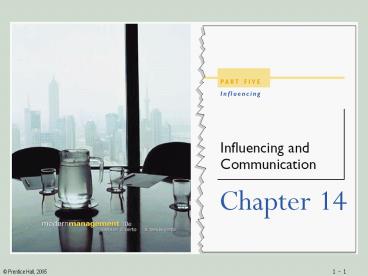Modern Management, 10e (Certo) - PowerPoint PPT Presentation
1 / 20
Title:
Modern Management, 10e (Certo)
Description:
4. An appreciation for the importance of nonverbal communication ... 4. Constant need to learn new concepts reduces time available for communication. Microbarriers ... – PowerPoint PPT presentation
Number of Views:137
Avg rating:3.0/5.0
Title: Modern Management, 10e (Certo)
1
(No Transcript)
2
Objectives
- 1. An understanding of the relationship between
influencing and emotional intelligence - 2. An understanding of interpersonal
communication - 3. A knowledge of how to use feedback
- 4. An appreciation for the importance of
nonverbal communication - 5. Insights into formal organizational
communication - 6. An appreciation for the importance of the
grapevine - 7. Some hints on how to encourage organizational
communication
3
Fundamentals of Influencing
- Defining Influencing
- The Influencing Subsystem
- 1. Leading
- 2. Motivating
- 3. Considering groups
- 4. Communicating
- 5. Understanding people
- 6. Encouraging creativity and innovation
- Emotional Intelligence
4
Fundamentals of Influencing
5
Fundamentals of Influencing
6
Fundamentals of Influencing
7
Fundamentals of Influencing
8
Communication
- Interpersonal Communication
- How Interpersonal Communication Works
- 1. The source/encoder
- 2. The signal
- 3. The decoder/destination
- Successful and Unsuccessful Interpersonal
Communication
9
Communication
10
Communication
11
Communication
- Interpersonal Communication (continued)
- How Interpersonal Communication Works (continued)
- Barriers to Successful Interpersonal
Communication - Macrobarriers
- 1. Increasing need for information
- 2. Need for increasingly complex information
- 3. Reality that people in U.S. are coming in
contact with people who dont use English - 4. Constant need to learn new concepts reduces
time available for communication - Microbarriers
- 1. Sources view of the destination
- 2. Message interference
- 3. Destinations view of the source
- 4. Perception
- 5. Multimeaning words
12
Communication
- Interpersonal Communication (continued)
- Feedback and Interpersonal Communication
- Gathering and Using Feedback
- Achieving Communication Effectiveness
- 1. Seek to clarify your ideas before
communicating - 2. Examine the true purpose of each
communication - 3. Consider total physical and human setting
whenever you communicate - 4. Consult with others,when appropriate, in
planning communications - 5. Be mindful of the overtones while you
communicate - 6. Take the opportunity to convey something of
help or value - 7. Follow up your communication
- 8. Communicate for tomorrow as well as today
- 9. Be sure your actions support your
communications - 10. Seek not only to be understood, but also to
understand
13
Communication
- Interpersonal Communication (continued)
- Verbal and Nonverbal Interpersonal Communication
- The Importance of Nonverbal Communication
14
Communication
- Interpersonal Communication in Organizations
- Formal Organizational Communication
- Types of Formal Organizational Communication
- 1. Downward
- 2. Upward
- 3. Lateral
- Patterns of Formal Organizational Communication
15
Communication
16
Communication
- Interpersonal Communication in Organizations
(continued) - Informal Organizational Communication
- Patterns of Informal Organizational Communication
- Grapevine characteristics
- 1. Springs up and is used irregularly within the
organization - 2. Not controlled by top executives
- 3. Exists largely to serve the self-interests of
the people within it - Grapevine patterns
- 1. The single-strand grapevine
- 2. The gossip grapevine
- 3. The probability grapevine
- 4. The cluster grapevine
- Dealing with Grapevines
17
Communication
18
Communication
- Interpersonal Communication in Organizations
(continued) - Encouraging Formal Organizational Communication
- Listen attentively to messages that come through
formal channels. - Support the flow of clear and concise statements
- Ensure that all members have free access to
formal channels - Assign specific communication responsibilities to
staff
19
Communication
20
- ?
Questions































